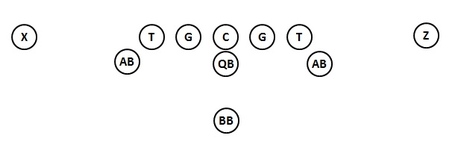This first post will examine parts of the flexbone triple option offense. We will spend a few posts discussing this offense, as it is quite complex and has several implementations. We WILL face this offense at least twice this season, so it's a great place to start our series of "Know Your Opponent"!
First, there's a ton of stuff online if you do a Google search of "Flexbone Triple Option". You can also search for playbooks from the service academies, as both Army and Navy run the offense (so does Georgia Tech, since Coach Johnson was formerly at Navy). We will keep our discussion central to the implementation we will see at the high school level, specifically from the teams we will face on our schedule this year.
What is Flexbone? Flexbone is a formation, like an "I-formation" or a "Spread" formation. Flexbone aligns two split ends detached from the formation with two slot backs and a single fullback directly behind the QB (see below).

What is "Option"? Option means the QB has an option of who ultimately is the ball carrier on any given play, and he will make his decision AFTER the ball has been snapped by READING what the DEFENDER does. Triple option means the QB has three options: give to FB, keep it, or pitch it to a slot back. Double option means the QB has two options, usually give to FB or keep it, but also keep it or pitch it (like speed option).
The basis of the Flexbone Option offense is the Midline (usually a double option) and the Veer (triple option). The Veer can be run inside or outside, which we'll discuss in a future post.
Midline: The offense wants to establish the FB up the A-gap! The offense will double team the backside A-gap defender (such as our Nose) with the Center & backside Guard - their job is to get movement and WIDEN the frontside A gap so the FB has more room to work. The playside Guard will release (usually inside) around the first defender past the Center (our 3-tech Tackle). The OL will drill this release move EVERY DAY and the G will be quite good at turning his shoulders to the DL to avoid contact. The QB will get his eyes on the DT immediately and watch what he does as the play develops (this is the READ). If the DT closes the A-gap and tackles the FB, then the QB will keep the ball and get upfield through the B gap where the DT was pre-snap. Often in the Flexbone the offense will lead through the B gap with the playside slot back, which is why some people refer to this play as QB Iso. If the DT sits in the B gap or hesitates, the QB will let the FB keep the ball and the FB will run through the A gap with a full head of steam. The playside OT will look to kickout the DE and widen the B gap. The backside OT will look to cut off B gap and hinge to C gap, protecting from backside pursuit.

These offenses will compliment the Midline play with a Trap on the DT. The idea is that the DT will get used to seeing the FB get the ball so he will fly upfield to tackle the FB, leaving himself vulnerable to the backside pulling Guard. The C will block back on the N for the pulling G while both OT will look to release up to the LB level (alternatively, the playside OT will kickout the DE making the play appear just like Midline while the playside slot leads up on the LB). This play is not an option, as it is pre-determined who is the ball carrier (the FB).
As you can see, the basis of the inside run game for Flexbone Option teams is an attack on the A-B gaps and exploitation of the 3-technique DT. Movement on the Nose by the use of double teams is also an emphasis, as these teams really want to widen the A gaps. Many teams will use wide OL splits to help widen the A gaps, too.
Next time we will examine the Flexbone Veer (inside & outside) plays and their complements.
No comments:
Post a Comment